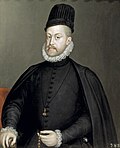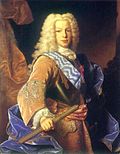Here you have a timeline
History in Spain (17th Century) on dipity
SPAIN
Kingdom of Spain
Spain is a democracy organised in the form of a parliamentary government under a constitutional monarchy
King Juan Carlos I
Its mainland is bordered to the south and east by the Mediterranean Sea except for a small land boundary with the British Overseas Territory of Gibraltar; to the north and north east by France, Andorra, and theBay of Biscay; and to the northwest and west by the Atlantic Ocean and Portugal.
Spanish territory also includes the Balearic Islands in the Mediterranean, the Canary Islands in the Atlantic Ocean off the African coast, and two autonomous cities in North Africa, Ceuta and Melilla, that border Morocco.
| Capital | Madrid | |
| Official languages | Spanish | |
|---|---|---|
| Recognised regional languages | ||
| Area | ||
|---|---|---|
| - | Total | 505,992 km2 |
| Population | ||
|---|---|---|
| - | 2012 | 47,265,321 inhabitants |
Highest mountain: Teide 3,718 m.
Highest mountain in Peninsula: Mulhacén 3,478 m.
Highest Mountain in Pyrenees: Aneto 3,404 m.
MOUNTAIN RANGES

Longest river: Tajo 1,038 km
Largest river: Ebro 426 m3/s
RIVERS
| Autonomous community | Capital | Provinces | ||
|---|---|---|---|---|
| Seville | Malaga, Almeria, Huelva, Cadiz, Cordoba, Jaen, Granada and Seville | |||
| Zaragoza | Aragón, Teruel and Zaragoza | |||
| Oviedo | Asturias | |||
| Palma de Mallorca | Balearic Islands | |||
| Vitoria - Gasteiz | Alava, Guipuzcoa and Vizcaya | |||
| Santa Cruz and Las Palmas | Tenerife and Gran Canaria | |||
| Santander | Cantabria | |||
| Toledo | Guadalajara, Cuenca, Albacete, Ciudad Real and Toledo | |||
| Valladolid | León, Valladolid, Zamora, Palencia, Soria, Segovia, Avila, Burgos and Salamanca | |||
| Barcelona | Lleida, Girona, Tarragona and Barcelona | |||
| Madrid | Madrid | |||
| Mérida | Caceres and Badajoz | |||
| Santiago de Compostela | Lugo, Ourense, Pontevedra and A Coruña | |||
| Logroño | La Rioja | |||
| Murcia | Murcia | |||
| Pamplona | Navarra | |||
| Valencia | Alicante, Castellon and Valencia |
| Autonomous city | ||
|---|---|---|
Descripción
Would you know to locate the geographic items you are asked about? You must point out each exact location on the map.
KINGS OF SPAIN
Kingdom of Spain (1479–1873)
House of Trastamara (1516–1555)
Under Isabella and Ferdinand, the kingdoms of Castilla and Aragon were united.| Name | Lifespan | Reign start | Reign end | Notes | Family | Image |
Joanna I
| 6 November 1479 – 12 April 1555(aged 75) | 26 November 1504 | 12 April 1555 | daughter of Ferdinand II of Aragon &Isabella I of Castile | House of Trastamara |  |
House of Habsburg (1516–1700)
Main article: Habsburg Spain
Under Joanna and Charles I, the two thrones of Castile and Aragon were finally united under one monarch.| Name | Lifespan | Reign start | Reign end | Notes | Family | Image |
| Charles I (Charles V of HRE)
| 24 February 1500 – 21 September 1558(aged 58) | 14 March 1516 | 16 January 1556 (abdicated) | Son of Juana of Castile & Philip I of Castile | Habsburg |  |
Philip II
| 21 May 1527 – 13 September 1598(aged 71) | 16 January 1556 | 13 September 1598 | Son of Charles I | Habsburg |  |
Philip III
| 14 April 1578 – 31 March 1621(aged 42) | 13 September 1598 | 31 March 1621 | Son of Philip II | Habsburg |  |
Philip IV
| 8 April 1605 – 17 September 1665(aged 60) | 31 March 1621 | 17 September 1665 | Son of Philip III | Habsburg |  |
Charles II
| 6 November 1661 – 1 November 1700(aged 38) | 17 September 1665 | 1 November 1700 | Son of Philip IV | Habsburg |  |
House of Bourbon (1700–1808)
Main article: Enlightenment in Spain
In the year 1700 Charles II died. Charles' will named the 16-year old Philip, the grandson of Charles' sister Maria Theresa of Spain, as his successor. Upon any possible refusal the Crown of Spain would be offered next to Philip's younger brother Charles, duc de Berry, or, next, to Archduke Charles of Austria.Both claimants, Philip and Charles, had a legal right to the Spanish throne due to the fact that Philip's grandfather, King Louis XIV of France and Charles's father, Leopold I, Holy Roman Emperor, were sons of Charles' aunts, Anne of Austria and Maria Anna of Austria. Philip had the better claim because his grandmother and great-grandmother were older than Leopold's. However, the Austrian branch claimed that Philip's grandmother had renounced the Spanish throne for herself and her descendants as part of her marriage contract. This was countered by the French branch's claim that it was on the basis of a dowry that had never been paid.
After a long council meeting where the Dauphin spoke up in favour of his son's rights, it was agreed that Philip would ascend the throne. Following this war broke out and Archduke Charles was also proclaimed king of Spain, as Charles III in opposition to Philip V.He was proclaimed in Vienna, and also in Madrid in the years 1706 and 1710. Charles renounced his claims to the Spanish throne in the Treaty of Rastatt of 1714, but was allowed the continued use of the styles of a Spanish monarch for his lifetime.
| Name | Lifespan | Reign start | Reign end | Notes | Family | Image |
Philip V
| 19 December 1683 – 9 July 1746(aged 62) | 16 November 1700 | 14 January 1724 (abdicated) | Great-grandson of Philip IV | Bourbon |  |
Louis I
| 25 August 1707 – 31 August 1724(aged 17) | 14 January 1724 | 31 August 1724 | Son of Philip V | Bourbon |  |
Philip V
| 19 December 1683 – 9 July 1746(aged 62) | 6 September 1724 | 9 July 1746 | Father of Louis I | Bourbon |  |
Ferdinand VI
| 23 September 1713 – 10 August 1759(aged 45) | 9 July 1746 | 10 August 1759 | Son of Philip V | Bourbon |  |
Charles III
| 20 January 1716 – 14 December 1788(aged 72) | 10 August 1759 | 14 December 1788 | Son of Philip V | Bourbon |  |
Charles IV
| 11 November 1748 – 20 January 1819(aged 70) | 14 December 1788 | 19 March 1808 (abdicated) | Son of Carlos III | Bourbon |  |
Ferdinand VII
| 14 October 1784 – 29 September 1833(aged 48) | 19 March 1808 | 6 May 1808 (abdicated) | Son of Charles IV | Bourbon |  |
House of Bonaparte (1808–1813)
Main article: Kingdom of Spain (Napoleonic)
The only monarch from this dynasty was Joseph, imposed by his brother Emperor Napoleon I of France after the kings Charles IV and Ferdinand VII abdicated. The title used by Joseph was King of the Spains and the Indias, by the Grace of God and the Constitution of the State. He was also later given all of the titles of the previous kings. A government in opposition to the French was formed in Cádiz on 25 September 1808, which continued to recognize the imprisoned Ferdinand VII as king. This government was diplomatically recognized as the legitimate Spanish government by Britain and other countries at war with France.| Name | Lifespan | Reign start | Reign end | Notes | Family | Image |
Joseph Bonaparte
| 7 January 1768 – 28 July 1844(aged 76) | 6 June 1808 | 11 December 1813 (deposed) | Bonaparte |  |
House of Bourbon (1813–1868)
Main article: Mid-nineteenth century Spain
Charles IV's eldest son was restored to the throne. Again the title used was king of Castile, Leon, Aragon,… by the Grace of God.| Name | Lifespan | Reign start | Reign end | Notes | Family | Image |
Ferdinand VII
| 14 October 1784 – 29 September 1833(aged 48) | 11 December 1813 | 29 September 1833 | Son of Charles IV | Bourbon |  |
Isabella II
| 10 October 1830 – 10 April 1904(aged 73) | 29 September 1833 | 30 September 1868 (deposed) | Daughter of Ferdinand VII | Bourbon |  |
House of Savoy (1870–1873)
Main article: Glorious Revolution (Spain)
After the Spanish Revolution of 1868 deposed Isabella II, there was established a provisional government and a regency headed by Francisco Serrano y Domínguez from October 8, 1868 until January 2, 1871, while a new monarch was sought. Amadeo was elected as king and the new title used wasKing of Spain, by the Grace of God and will of the nation.| Name | Lifespan | Reign start | Reign end | Notes | Family | Image |
Amadeo I
| 30 May 1845 – 18 January 1890(aged 44) | 16 November 1870 | 11 February 1873 (abdicated) | Elected by Cortes Generales | Savoy |  |
Spanish Republic (1873–1874)
Kingdom of Spain (1874–1931)
House of Bourbon (1874–1931)
Main article: Spain under the Restoration
Isabella II's eldest son was restored to the throne as she had abdicated in his favour in 1870. Constitutional King of Spain.| Name | Lifespan | Reign start | Reign end | Notes | Family | Image |
Alfonso XII
| 28 November 1857 – 25 November 1885(aged 27) | 29 December 1874 | 25 November 1885 | Son of Isabella II | Bourbon |  |
Alfonso XIII
| 17 May 1886 – 28 February 1941(aged 54) | 17 May 1886 | 14 April 1931 (abdicated) | Son of Alfonso XII | Bourbon |  |
Spanish Republic (1931–1939)
Spanish State (1936–1975)
On 1 October 1936 General Francisco Franco was proclaimed Leader of Spain (Spanish: Caudillo de España) in the parts of Spain controlled by the Nationalists (nacionales) after the Spanish Civil War broke out. After the end of war on 1 April 1939 General Franco took control of the whole of Spain. In 1947, Franco proclaimed the restoration of the monarchy but did not allow the pretender, Juan Carlos, Count of Barcelona, to take the throne. In 1969, Franco declared that Juan Carlos, Prince of Spain, the Count of Barcelona's son, would be his successor. After Franco's death in 1975, Juan Carlos succeeded him as the King of Spain.Kingdom of Spain (1975–present
House of Bourbon (1975–present)
Main article: Spanish transition to democracy
Alfonso XIII's claim descended (due to his two eldest sons' renunciations) to his third son, Juan Carlos, Count of Barcelona, who was passed over in favour of his eldest son, whose title is King of Spain. The Count of Barcelona renounced his claims in favour of his son in 1977, two years after Franco's death and Juan Carlos's accession.| Name | Lifespan | Reign start | Reign end | Notes | Family | Image |
| Juan Carlos I[5] | 5 January 1938 (age 75) | 22 November 1975 | Incumbent | Grandson of Alfonso XIII | Bourbon |  |





No comments:
Post a Comment